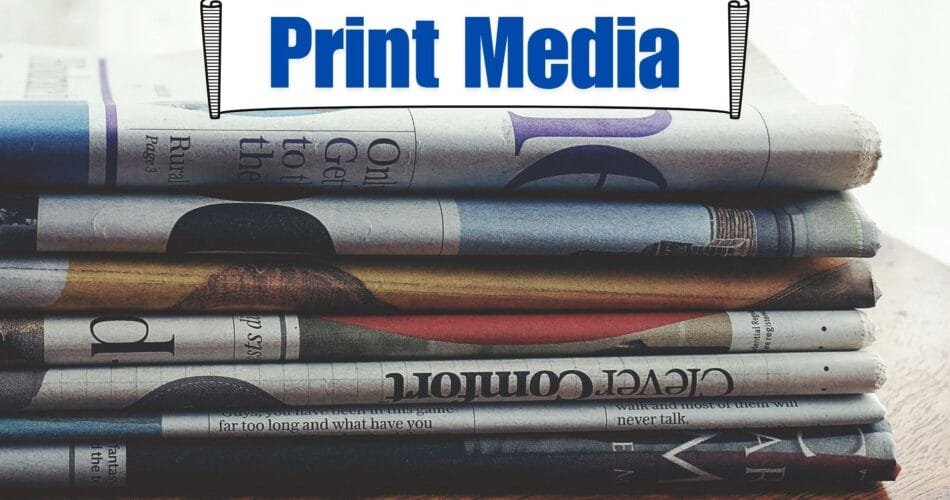This blog contains information about Print Media. In the start, it introduces and explains Print media in detail. Then it discusses the complete Evolution of Print Media. It also elaborates the Current Trends in Print Media. Then it answers the question that Why print media matters? It also discovers the Print media and Sustainability. It also tells how to create effective Print media Campaign? In the end, it discusses some Frequently Asked Questions about Print media. This blog contains significance and Evolution of Print Media.
Introduction to Print Media:
Print media refers to a broad category of publications that encompasses newspapers, magazines, books, brochures, and other tangible materials that convey information through printed text and images.
The history of print media is rich and varied, dating back to the invention of the printing press in the 15th century by Johannes Gutenberg. This groundbreaking development revolutionized the dissemination of information, making written materials more accessible to the general populace. Over the centuries, print media has evolved significantly, transitioning from simple pamphlets and traditional newspapers to glossy magazines and comprehensive books. This blog contains Significance and Evolution of Print Media.
In today’s digital age, where information is often consumed through screens, the relevance of print media continues to endure. Many individuals and organizations recognize the unique qualities that printed content offers, such as tangibility, permanence, and the ability to create a deeper engagement. Unlike digital formats, print media engages readers with a sensory experience, allowing them to physically hold and manipulate the publication. The act of reading printed material can foster concentration and comprehension, reducing distractions that are often present in a digital environment.
Moreover, print media has maintained its significance within various industries, including education, advertising, and journalism. Educational institutions frequently utilize printed books and handouts as essential learning resources. In advertising, brochures and flyers serve as tangible marketing materials that can leave a lasting impression on consumers. Despite the increasing reliance on digital platforms, print media’s distinct advantages ensure its continued relevance. As society embraces technological advancements, it also recognizes the necessity of balancing digital consumption with traditional forms of media. The enduring value of print media is firmly rooted in its ability to connect with audiences in ways that digital formats sometimes cannot achieve.
The Evolution of Print Media:
The history of print media dates back to the 15th century with the invention of the printing press by Johannes Gutenberg in 1440. This groundbreaking technology revolutionized the way information was disseminated, paving the way for literacy and the spread of ideas. Initially, print media consisted predominantly of religious texts and pamphlets which served the needs of a society hungry for information.
As the centuries progressed, print media continued to evolve. The 17th century saw the emergence of newspapers, which played a critical role in shaping public opinion and fostering community engagement. By the 18th century, periodicals such as journals and magazines became popular, addressing a diverse range of topics and interests. This period marked a significant transition in print media, as it began to cater to the growing demand for leisure reading and information beyond the confines of traditional news.
The 19th century brought about industrial advances, including steam-powered printing presses, which enabled mass production of printed materials. This enhancement lowered costs and expanded access to print media, solidifying its position in everyday life. The introduction of color printing in the late 19th century further enriched the visual appeal and marketability of newspapers and magazines.
Print Media in 20th century:
With the dawn of the 20th century, print media faced new challenges and opportunities. The rise of radio and later television, created competition for audience attention. However, print media adapted by incorporating compelling visuals and engaging narratives. The introduction of digital technology in the late 20th century marked yet another pivotal point. While many predicted the decline of print, successful adaptations saw print media harnessing digital platforms to reach wider audiences, ensuring that traditional formats found new life in a rapidly changing landscape.
Today, print media continues to thrive alongside digital platforms, showcasing its resilience and ability to adapt. This rich history underscores the enduring significance of print media as it navigates modern challenges while maintaining its cherished traditions. This blog contains Significance and Evolution of Print Media.

Current Trends in Print Media
The print media industry is experiencing notable transformations as it adapts to contemporary demands and technological advancements. The current trends includes the following:
Integration of Digital and Print Formats:
One of the prominent trends is the integration of digital and print formats, which allows for a more versatile approach to content consumption. Publishers are increasingly adopting augmented reality (AR) features in printed materials, enabling readers to interact with content through their smartphones. This combination not only enhances engagement but also creates a more immersive reading experience, bridging the gap between traditional print and modern digital landscapes.
Niche Publications:
Additionally, the rise of niche publications has significantly impacted the print media sector. As audiences become more discerning, there is a growing demand for content tailored to specific interests and demographics. Magazines focusing on specific hobbies, industries, or lifestyles are flourishing, allowing advertisers to target highly engaged readers. This trend reflects a broader shift towards specialization, where smaller, expertly curated publications can compete with larger, more generalized media outlets by offering unique insights and localized content.
Personalized Print Products:
Personalized print products are also gaining traction, providing consumers with customized options that enhance their connection to printed materials. From bespoke photo books to individualized magazines, this trend caters to the desire for unique, tailored experiences in a world where mass production often prevails. Companies employing data-driven insights to create tailored print products are witnessing increased customer satisfaction and loyalty, illustrating the effectiveness of personalization in the print medium.
Statistics underline these emerging trends, with reports indicating a year-over-year growth in engagement with print media that integrates digital elements. As the industry adapts to these trends, it demonstrates a resilient capacity for innovation, ensuring that print media continues to thrive alongside its digital counterparts.
Why Print Media Still Matters?
In a world increasingly dominated by digital communication, print media maintains a significant presence, particularly in marketing and communication strategies. The tactile nature of print materials, such as brochures, magazines, and direct mail, invokes a sensory experience that digital formats often lack. This physical interaction enhances memory recall and helps consumers better retain information. Research has shown that people tend to trust printed materials more than their digital counterparts. Its contributing to a lasting impression and a sense of legitimacy. The credibility associated with print media can be invaluable for brands aiming to establish or reinforce their message in the minds of consumers.
Advantages of Print Media:
One of the key advantages of print media lies in its ability to convey messages effectively. Unlike digital platforms where information can be rapidly consumed and easily overlooked, print media allows for a deliberate and engaging presentation of content. Readers often take the time to explore printed materials, which is difficult to replicate in the fast-scrolling environment of digital screens.
The design and layout of print content can also significantly influence how messages are perceived. It is facilitating a more focused narrative and encouraging deeper engagement.
Moreover, print media fosters engagement through its unique characteristics. For instance, print campaigns can stimulate curiosity and encourage interaction in ways that digital campaigns may struggle to achieve. Direct mail campaigns can reach audiences in their homes, providing a personal touch that digital marketing often lacks. Surveys indicate that consumers tend to respond more positively and engage more thoroughly with print advertisements, amplifying their purchasing intention. The strategic integration of print media within an overall marketing strategy can, therefore, enhance consumer engagement, helping businesses build lasting relationships with their target audience. As a vital component of a holistic marketing approach, print media continues to resonate with consumers. With proving that it still matters in today’s digital world. This blog contains Significance and Evolution of Print Media.
Print Media and Sustainability: A Modern Challenge
In contemporary discussions surrounding environmental responsibility, print media often comes under scrutiny for its ecological footprint. The production processes involved in print media, including paper manufacturing and ink creation, can contribute significantly to deforestation and pollution. However, the industry is continually evolving to adopt sustainable practices that mitigate these impacts.
One promising development in print media is the increasing use of eco-friendly materials. Many publishers are now opting for recycled paper, which not only reduces the demand for virgin materials but also minimizes waste in landfills. Additionally, advancements in biodegradable inks derived from natural sources are helping to lower the environmental burden. That is associated with traditional printing processes. These initiatives reflect a growing commitment within the industry to pursue greener alternatives without compromising on quality.
Recycling initiatives play a critical role in promoting sustainability within print media. Many companies are establishing programs that facilitate the recycling of printed materials, ensuring that they are repurposed rather than discarded. This not only helps alleviate waste but also encourages consumers to engage with the ecological responsibilities tied to media consumption. By implementing closed-loop systems, publishers can effectively reduce their carbon footprint and further enforce a culture of sustainability.
Moreover, the advent of sustainable printing technologies is revolutionizing the industry. Digital printing processes, for instance, often produce less waste than traditional methods. Since they allow for on-demand printing, which minimizes excess output. These innovations are crucial as they aim to balance print media’s benefits—such as tangible, engaging content—with its ecological responsibilities. The challenge remains to ensure that these advancements are widely adopted without sacrificing the artistic and communicative nature of print. In conclusion, while print media faces significant environmental challenges, its potential for sustainability is increasingly being recognized and acted upon, paving the way for a responsible future. This blog contains Significance and Evolution of Print Media.
How to Create Effective Print Media Campaigns?
Creating effective print media campaigns requires a strategic approach, focusing on several key elements to ensure that the message resonates with the target audience.
Clear Objectives:
The first step in this process is to define clear objectives. Whether the goal is to increase brand awareness, drive sales, or promote a specific event, having well-defined objectives. This guides the campaign’s direction and measurement criteria.
Understanding Target Audience:
Next, identifying and understanding the target audience is crucial for crafting a compelling message. This involves using market research to gather insights on demographics, preferences, and behaviors. By analyzing these factors, marketers can tailor their messaging and visual designs to resonate with their intended audience, ensuring higher engagement and conversion rates.
Selection of Print Formats:
The selection of print formats also plays a significant role in the campaign’s success. Options like brochures, flyers, posters, and direct mail each serve different purposes based on target audience preferences. For example, a high-quality brochure may appeal to a discerning client base, whereas vibrant posters may attract the attention of passersby in a busy urban setting. The choice of paper quality, color schemes, and typography should align with the overall brand identity while enhancing visibility.
Measuring the Effectiveness:
Once the campaign is launched, measuring its effectiveness is essential to understand its impact and guide future efforts. Metrics such as response rates, conversion rates, and customer feedback provide valuable data on how well the print media has performed. Employing tools like unique promo codes or QR codes can help trace interactions back to print materials. Netflix, for instance, successfully executed a print campaign targeting local cinemas, resulting in measurable engagement and subsequent subscription growth.
By adhering to these guidelines, businesses can develop impactful print media campaigns that successfully merge traditional marketing techniques with modern audience engagement strategies. This blog contains Significance and Evolution of Print Media.
The Future of Print Media in a Digital Age:
The future of print media in a digital age presents a complex landscape, shaped by rapid technological advancements and evolving consumer preferences. As digital platforms dominate the information dissemination process, traditional print mediums face increasing pressure to adapt and innovate. However, experts suggest that print media is not merely destined for obsolescence. Rather, it stands to undergo a significant transformation that could enhance its relevance and functionality.
One emerging trend is the integration of augmented reality (AR) and interactive elements within print publications. This innovative approach allows readers to engage with content in a tactile manner while accessing digital features through QR codes or AR applications. By bridging the gap between the physical and digital worlds, print media can offer an enriched experience. It captures the attention of a tech-savvy audience.
Moreover, print media companies are increasingly focusing on niche markets and specialized content, catering to specific interests. This strategy fosters a loyal readership base that values high-quality, curated content over the often overwhelming volume of information available online. The return to artisanal craftsmanship in print production, including the use of premium materials and unique designs. It also contributes to the perceived value of print products, setting them apart in the marketplace.
Additionally, sustainability is becoming a pivotal concern within the print industry. Publishers are exploring eco-friendly practices, such as using recycled paper and non-toxic inks, to appeal to environmentally conscious consumers. By prioritizing sustainability, print media can align itself with contemporary values, further ensuring its longevity in a competitive environment.
In conclusion, while the digital age poses significant challenges for print media, it also opens avenues for innovation and growth. By embracing technological advancements, focusing on niche markets, and adopting sustainable practices print media has the potential to thrive amid the digital transformation. This blog contains Significance and Evolution of Print Media.
Frequently Asked Questions about Print Media:
The resurgence of print media has prompted numerous inquiries, particularly regarding its relevance and cost-effectiveness in today’s digital landscape. One prevalent question is whether print media is still a viable option for businesses and individuals. Print offers unique advantages, such as tangible engagement and longevity, which can contribute to effective branding. In many cases, print materials can provide better retention rates compared to digital formats, making them an essential component of a comprehensive marketing strategy.
How to choose between Digital and Print Media?
Another common query revolves around how to choose between digital and print media. This decision often hinges on the target audience and the specific goals of a campaign. For instance, if the target demographic includes individuals who are more likely to consume content offline, print materials could be more effective. Conversely, digital media may reach a broader audience quickly, making it a better option for time-sensitive information. Therefore, an understanding of where your audience prefers to engage is crucial for making an informed choice.
Additionally, perceptual differences between print and digital media deserve attention. Print media is often associated with trustworthiness and quality due to its physical presence, while digital media allows for instant interaction and convenient access. This dichotomy can affect how consumers perceive a brand depending on the medium used for marketing. Furthermore, the choice between print and digital will also depend on other factors. These factors are budget constraints and the nature of the message being communicated. As marketers continue to navigate these mediums, they must optimize their strategies by thoughtfully assessing their objectives and audience preferences. This blog contains Significance and Evolution of Print Media.
Importance of Print Media:
Print media was a great mean of information and latest updates in the last century when digital and social media was not approached and invented. After the other forms of media, the print media becomes less powerful and was taken for granted. The importance of print media extends beyond personal consumption. It plays a critical role in the broader context of cultural preservation and information dissemination. In an age where information can be easily manipulated or lost in the digital noise, the permanence of printed materials provides a vital anchor for historical records and in-depth journalism. The uniqueness of print publications shines brightly as they continue to deliver quality content with a sense of authenticity. By allowing for richer narratives that captivate readers.
Conclusion
In light of the discussions presented, it is evident that print media is experiencing a remarkable rebirth amidst the pervasive influence of digital platforms. The resilience of print media can attribute to its ability to adapt to the shifting dynamics of communication. And demonstrating that traditional forms can coexist harmoniously with technological advancements. The tactile experience that print media offers remains unparalleled, providing an enduring connection that digital formats often lack.
The integration of print within a hybrid communication landscape exemplifies the need for a multifaceted approach to media consumption. As readers seek diverse and engaging experiences, the combination of print and digital formats allows for enhanced storytelling and greater accessibility. Publications are increasingly leveraging digital tools to complement their print offerings, thus creating a more holistic experience for their audience. This adaptability reflects the ongoing relevance of print media in an era dominated by instant access and digital content.
Ultimately, the legacy of print media is not merely about survival; it is about thriving through innovation and collaboration. Embracing both print and digital modalities ensures that audiences have access to a variety of information formats, enhancing the overall communication landscape. As we move further into the future, it is crucial to celebrate and nurture. The enduring significance of print media in our increasingly digital world. This blog contains Significance and Evolution of Print Media.

To learn about more topics, Click the links below:


Comments